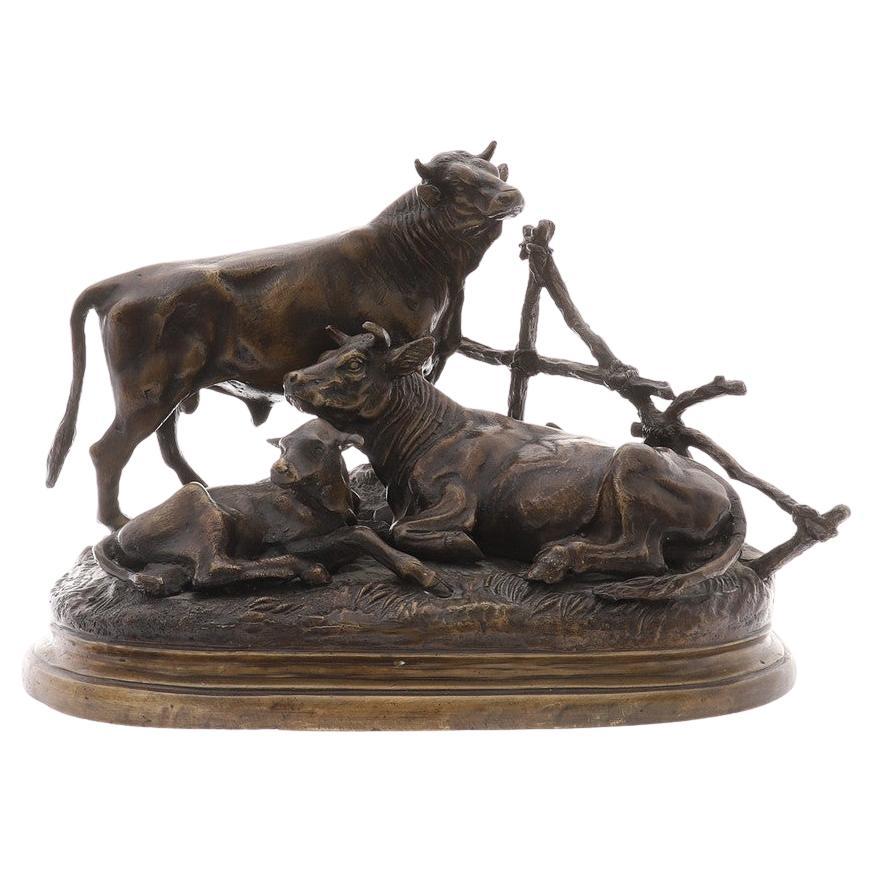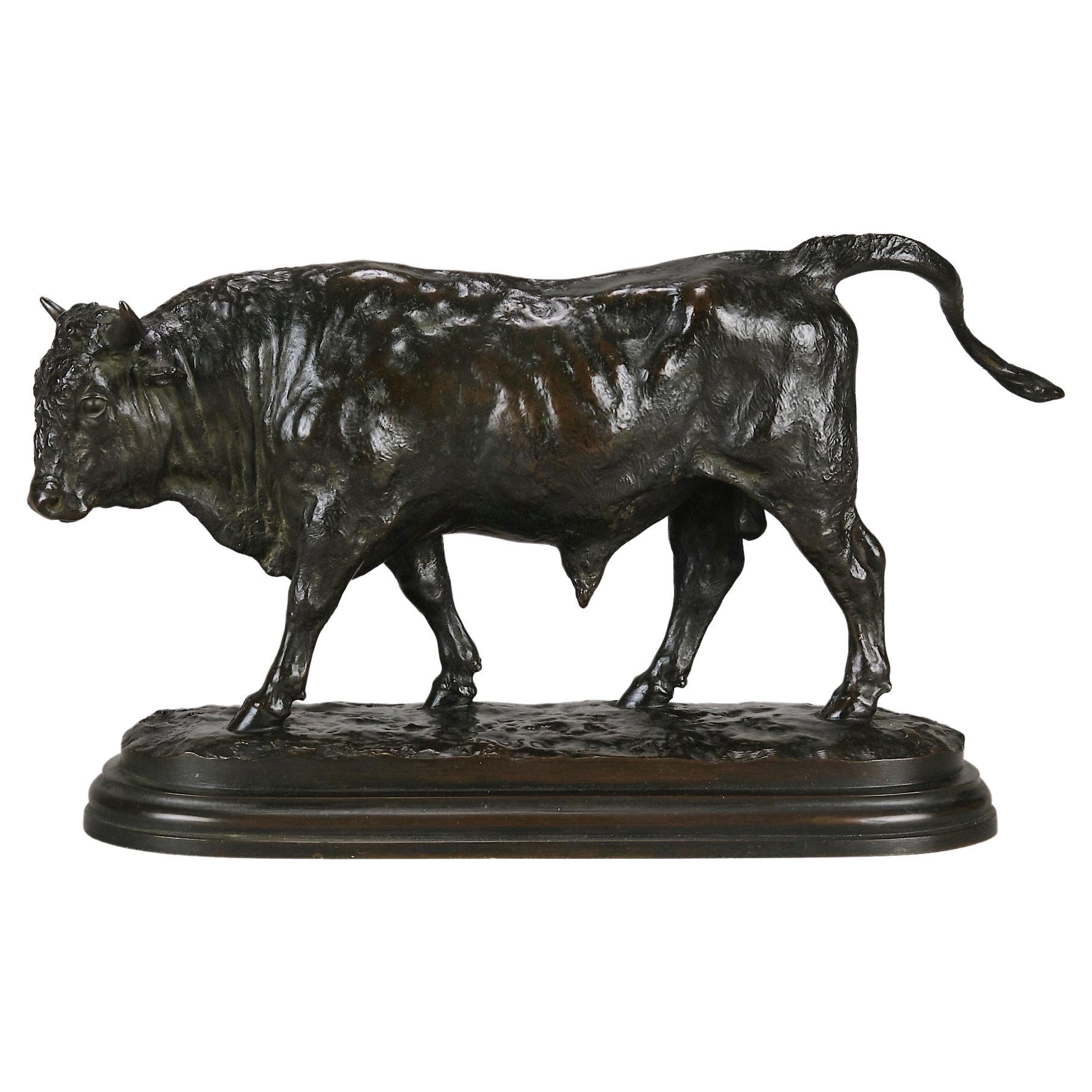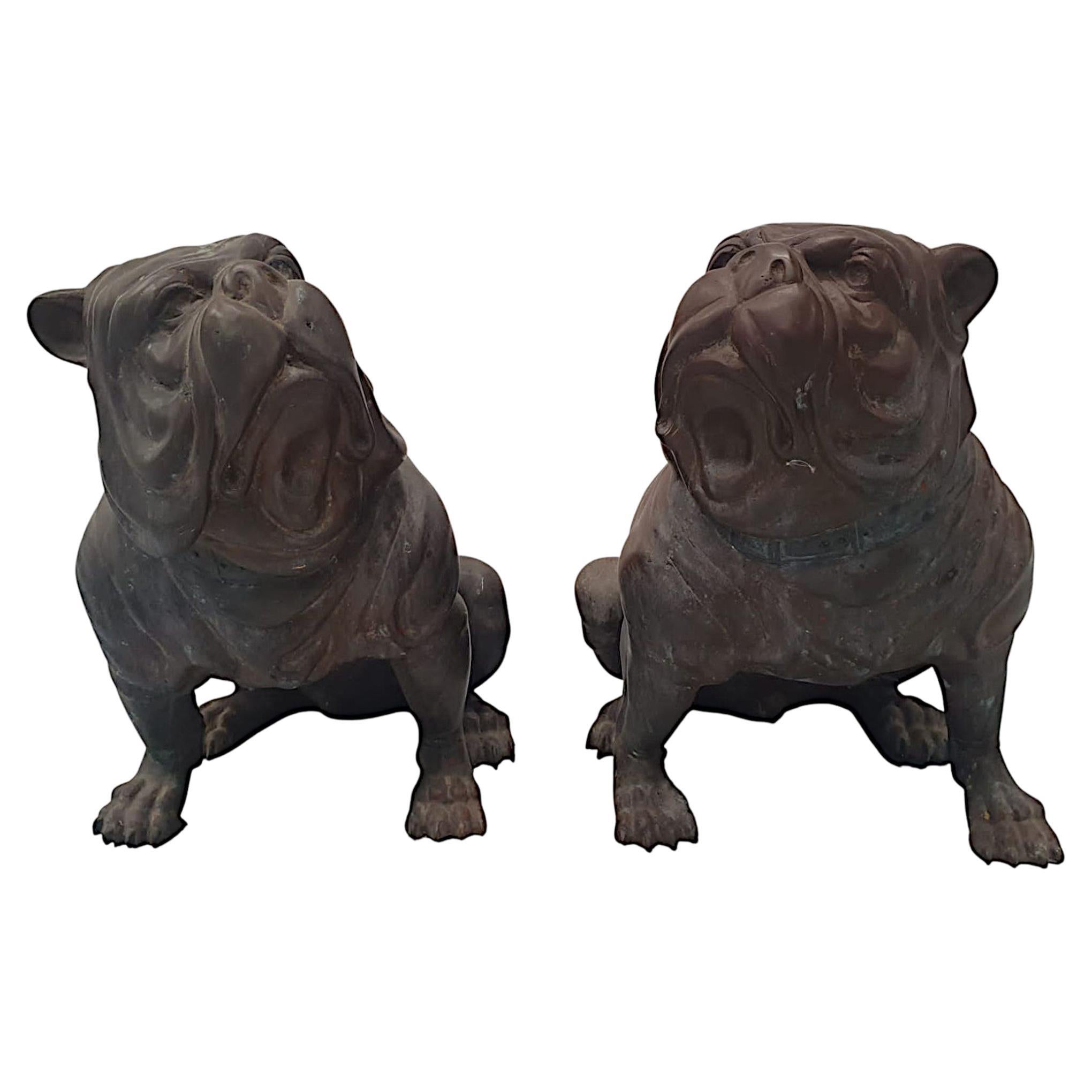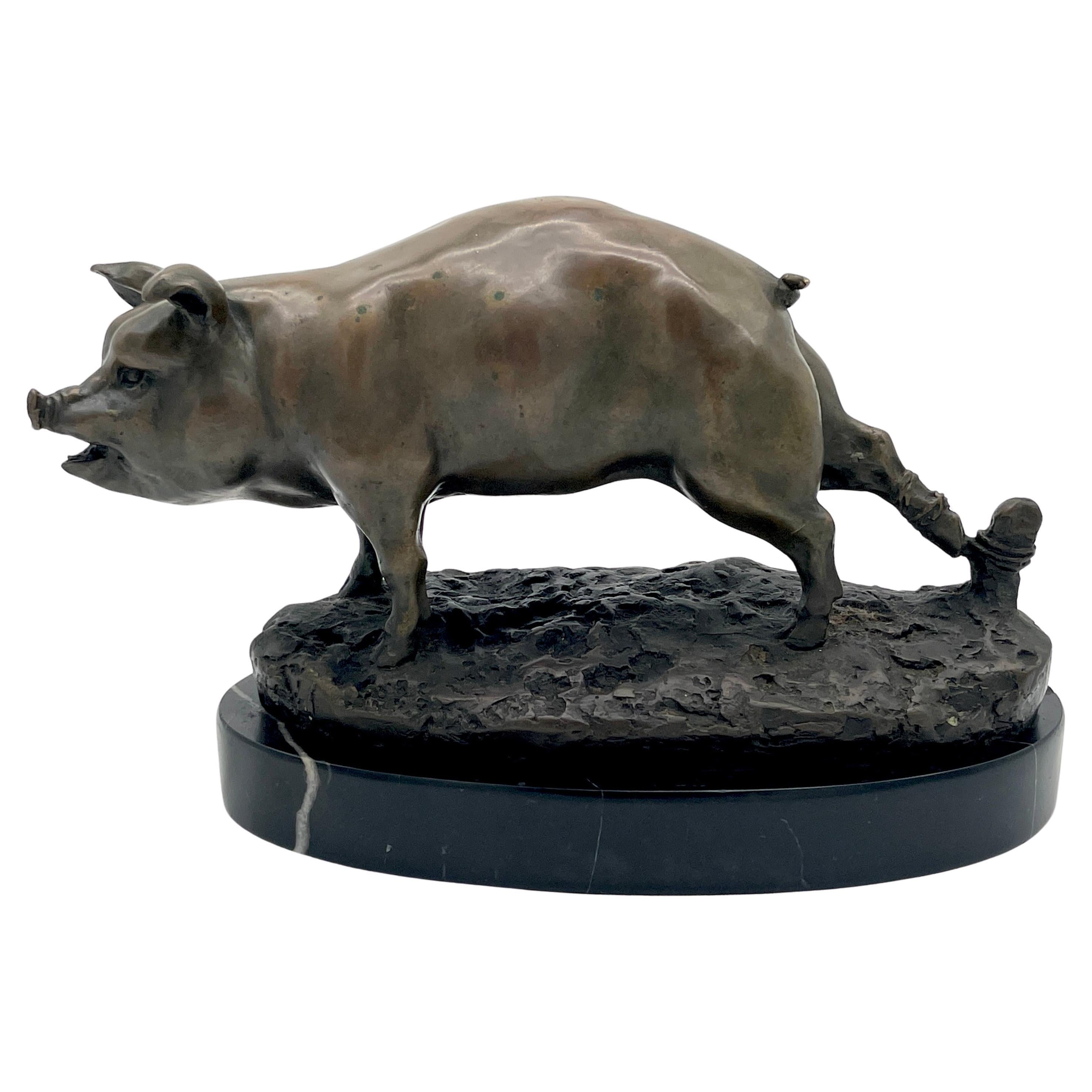Items Similar to A Fine Animalier School Bronze Figure of a Bull, After Rosa Bonheur (1822-1899)
Want more images or videos?
Request additional images or videos from the seller
1 of 11
A Fine Animalier School Bronze Figure of a Bull, After Rosa Bonheur (1822-1899)
About the Item
Although there is seemingly no apparent foundry mark, this finely cast & patinated animalier bronze known as ‘Bull’ or ‘Taureau Beuglant’ is exemplary in demonstrating exceptional attention to musculature, proportion, definition, and superior patination. Shown standing upon a fine naturalistically modelled base, signed in the mold Rosa B. Rosa Bonheur's bronzes were cast by the Peyrol Foundry, which was owned by Rosa Bonheur’s brother-in-law, Hippolyte Peyrol. Several examples attributed to Rosa Bonheur that do not bear the Peyrol foundry mark are often deemed to be cast by the Peyrol foundry, however we cannot make that claim with any degree of certainty as regards this model. Dimensions, 5.5” high x 8.5” wide x 3.75” deep.
Marie Rosalie (Rosa) Bonheur (1822-1899) was a member of the Animalier School of Sculptors, and in addition to having been a highly accomplished sculptor, she also exhibited paintings at the Paris Salon from 1841 until 1853, winning the Gold Medal twice, first in 1948 and again in 1849. Rosa Bonheur is listed in the reference guide titled 'Bronze Sculpture of “Les Animaliers” by Jane Horswell', on page #175, along with the illustration & description of this model shown on page #180. In that same reference guide it states …"she was a superb draughtsman, and the worth of her sculpture lies in its basic realism – not ‘humanised, her pictorial portrayal of the animal is absolutely as it exists in nature”.
- Similar to:Rosa Bonheur (Artist)
- Dimensions:Height: 5.5 in (13.97 cm)Width: 8.5 in (21.59 cm)Depth: 3.75 in (9.53 cm)
- Style:Beaux Arts (Of the Period)
- Materials and Techniques:
- Place of Origin:
- Period:
- Date of Manufacture:Circa 1900
- Condition:Replacements made: Later replaced screw(s) as observed on the underside of the base. Wear consistent with age and use. In extremely good overall condition, exhibiting an exceptionally fine old untouched patina. We make it policy not to disturb the surface of antique metal-ware so as to preserve the integrity of the patina that has taken decades to develop naturally.
- Seller Location:Ottawa, CA
- Reference Number:1stDibs: LU2728339567392
About the Seller
5.0
Vetted Seller
These experienced sellers undergo a comprehensive evaluation by our team of in-house experts.
Established in 1989
1stDibs seller since 2017
116 sales on 1stDibs
Typical response time: <1 hour
- ShippingRetrieving quote...Ships From: Ottawa, Canada
- Return PolicyA return for this item may be initiated within 2 days of delivery.
More From This SellerView All
- A Fine Grand Tour Style Bronze Bust of a Greek Philosopher After Mathurin MoreauBy Mathurin MoreauLocated in Ottawa, OntarioThis finely modelled Hellenistic inspired portrait bust is likely that of the Greek philosopher Chrysippus of Soli - regarded by scholars as the 2nd founder of the School of Stoicism...Category
Antique Late 19th Century French Hellenistic Busts
MaterialsBronze
- A Fine 19th Century Egyptian Revival Figural Bronze Furniture Mount, Circa 1830Located in Ottawa, OntarioA very attractive 19th century Egyptian Revival bronze furniture mount, cast in the form of a bust of a goddess wearing a tasseled robe, and adorned with a feathered headdress with f...Category
Antique Early 19th Century French Egyptian Revival Figurative Sculptures
MaterialsBronze
- Very Fine Terracotta Bust of Alexandre Brongniart, After Jean-Antoine HoudonBy Jean-Antoine HoudonLocated in Ottawa, OntarioA very fine early 20th century terracotta bust of Alexandre Brongniart, after the original work by Jean-Antoine Houdon. Demonstrating exacting proportions & finely sculpted features...Category
Early 20th Century French Victorian Busts
MaterialsMarble
- A Large Mid 20th Century Bronze of a Seated Woman in a Shawl, Mexican SchoolBy Felipe CastañedaLocated in Ottawa, OntarioThis large and impressive cast bronze figure of a seated woman in a shawI, showing expertly rendered features & exacting proportions, and exhibiting a medium /dark brown patina overall. Although apparently unsigned, both the subject matter and the pyramidal form of this work is highly representative of works by several noted 20th century Mexican artists, including those by noted Mexican sculptors Francisco Zuniga (1912 -1998), Armando Maya (1935-), and Felipe Castañeda...Category
Mid-20th Century Mexican Mid-Century Modern Figurative Sculptures
MaterialsBronze
- Fine Pair of Grand Tour Style Miniature Bronze Busts, Continental, circa 1900By Gladenbeck FoundryLocated in Ottawa, OntarioA very handsome pair of classical bronze busts raised on white alabaster columns decorated with gilt metal rings, atop squared rouge royal marble...Category
Early 20th Century German Grand Tour Busts
MaterialsAlabaster, Bronze
- Fine Grand Tour Style Bronze of Mercury Mounted as a Table Lamp, Circa 1900By GiambolognaLocated in Ottawa, OntarioThe large & finely proportioned cast bronze figure of Mercury - Roman god of abundance & commercial success, shown standing atop the mouth of Aeolus - Ruler of the Four Winds, while ...Category
Early 20th Century European Grand Tour Table Lamps
MaterialsMarble, Bronze
You May Also Like
- French Bronze Figure of a Bull, by Rosa BonheurLocated in New York, NYInscribed "Rosa B" and stamped with the "Peyrol" foundry on the base.Category
Antique 1860s Animal Sculptures
MaterialsBronze
- 19th Century Animalier French Bronze Entitled "Taureau Debout" by Rosa BonheurBy Rosa BonheurLocated in London, GB"Taureau Debout" by Rosa Bonheur. An excellent late 19th Century French animalier bronze study of a standing bull with fine hand chased surface that accentuates the muscle definition of the subject, signed Rosa B. ADDITIONAL INFORMATION Measures: Width: 32 cm Height: 18 cm Depth: 11cm Condition: Excellent Original Condition Circa: 1870 Materials: Bronze Book reference: Animals in Bronze by Christopher Payne Page no. 174 DESCRIPTION Bonheur, Rosa (1822-1899) The most popular artist of nineteenth-century France, Rosa Bonheur was also one of the first renowned painters of animals and the first woman awarded the Grand Cross by the French Legion of Honor. A professional artist with a successful career, Bonheur lived in two consecutive committed relationships with women. Born on March 16, 1822 in Bordeaux, Marie Rosalie Bonheur was the oldest of the four children of Raimond Oscar Bonheur (1796-1849) and Sophie Marquis. Bonheur's father was an art teacher who came from a poor family, while her mother, a musician, had descended from a middle-class family and had been her husband's art student. Bonheur's father, who taught drawing and landscape painting, was an ardent member of the utopian Saint Simeon society. The group held idealistic beliefs about the reform of work, property, marriage, and the role of women in society. Most importantly, for the artist's future, the Saint Simeons questioned traditional gender norms and firmly believed in the equality of women. While teaching artistic techniques to his oldest daughter, Raimond Bonheur also encouraged her independence and taught her to consider art as a career. In 1828 Raimond Bonheur joined the Saint Simeons at their retreat outside Paris. Sophie and the children joined him in Paris the following year. Four years later, however, Raimond abandoned his family to live in isolation with his fellow Saint Simeons. Sophie Bonheur died in 1833 at the age of thirty-six. Rosa was only eleven years old when her mother died, but she was aware of the heavy price her mother paid for married life with a man who was more dedicated to his own ideals than to meeting his family's needs. Rosa also saw that her mother's marriage led to poverty and her death from exhaustion. After her mother's death, Bonheur was taken in by the Micas family who resided nearby. Mme Micas and Bonheur's mother had been friends. When Mme Bonheur died, the Micas family paid Raimond Bonheur's debts and cared for Rosa. Their daughther, Nathalie, who would later become an amateur inventor and unschooled veterinarian, and Rosa became enamored with each other. When Rosa Bonheur began her career as a professional artist, she had already been trained by her father who had allowed her to study in all male classes. Rosa also learned by sketching masterworks at the Louvre from the age of fourteen, and later, by studying with Léon Cogniet. From the very beginning, Bonheur's favorite subject was animals. She learned their anatomy completely by dissecting them in local slaughterhouses. She also visited the horse market two times a week. Study of animals by direct observation led to the formation of the realist style in which Bonheur worked. It was for such work that Bonheur obtained written permission from the French government to wear men's slacks. Her working attire also consisted of a loose smock and heavy boots that protected her feet from the dangerous environment in which she painted. The style of dress that the artist adopted for work and home may well have been influenced by her father's attire, which was based on St. Simeonian clothing experiments. Bonheur also cropped her hair, perhaps to facilitate her work. She did, however, always wear dresses for social occasions because she knew that appropriate dress would further her career. Bonheur earned a successful living as a painter of animals. She exhibited at the annual Paris Salon regularly from the age of nineteen in 1841 through 1853, when she was thirty-one. She won the salon's gold medal at the age of twenty-six in 1848 and was commissioned by the French government to paint Plowing on the Nivernais in 1849. In the same year Bonheur and her sister Juliette became directors of l'École gratuite de dessin pour les jeunes filles, a post their father had once held. Bonheur completed her most renowned work, The Horse Fair, in 1855. The successful representation of percherons (a breed native to Normandy) was purchased by Ernest Gambart, a London art dealer whose gallery specialized in work by French artists. He exhibited The Horse Fair in London where Bonheur visited with Nathalie. Queen Victoria requested a private viewing of the painting at Windsor Castle. It would later be purchased in 1887 by Cornelius Vanderbilt and donated to the new Metropolitan Museum of Art in New York City. Bonheur's trip to England allowed her to meet Charles Eastlake, then President of the Royal Academy, John Ruskin, the English writer and critic, and Edwin Landseer, the British animalier. She also toured the English and Scottish countrysides and executed some paintings based on her observations of new breeds of animals found there. Gambart made engravings of Bonheur's work, including The Horse Fair, and sold them in England, Europe, and the United States. Bonheur became one of the most renowned painters of the time. Little girls, such as Anna Klumpke in the United States, even had dolls in her likeness, much as American girls played with Shirley Temple dolls...Category
Antique 19th Century French Art Nouveau Animal Sculptures
MaterialsBronze
- Very Rare and Fine Early 20th Century Pair of Animalier Bronze Bull DogsLocated in Dublin, IEA very rare early 20th Century original pair of animalier bronze sculptures depicting a pair of bull dogs, finely cast with stunning detail and patination. The pair would be a ideal ...Category
Early 20th Century English Animal Sculptures
MaterialsBronze
- Decorative Bronze Figure of a Bull, Home Decor Objects After Jules MoigniezLocated in Hampshire, GBAn artistically created sculpture table decorative objects, After Jules Moigniez (French 1835-1894), bronze figure group modelled as a bull, cow and calf on the naturalistically modelled ground before a fence, upon an oval base, signed J Moigniez. This bronze with a brown patina, entitled “Bovine family...Category
Antique Early 1800s French Art Deco Sculptures and Carvings
MaterialsBronze
- French School Animalier Sculpture Bronze of a Roped Prize PigBy Antoine-Louis BaryeLocated in West Palm Beach, FLFrench School Animalier Sculpture Bronze of a Roped Prize Pig 20th Century France, Signed 'Barex' This 20th-century French School Bronze An...Category
20th Century European Sporting Art Animal Sculptures
MaterialsMarble, Bronze
- French Animalier Bronze Study Entitled 'Cheval Debout' by Isidore BonheurBy Isidore Jules BonheurLocated in London, GBFabulous late 19th Century French Animalier bronze study of a standing horse with wonderful rich dark brown lightly rubbed to mid/golden brown patina and excellent crisp surface detail, raised on a stepped integral base, signed I Bonheur ADDITIONAL INFORMATION Height: 13 cm Length: 19 cm Condition: Excellent Original Condition Circa: 1870 Materials: Bronze Book Ref Animals in Bronze by Christopher Payne Kjellberg Page no. 177 SKU: 8526 DESCRIPTION Isidore Bonheur Bonheur Cheval– Isidore Bonheur (1827 ~ 1901) was born on May 15th 1827 in Bordeaux, France, and died in Paris in 1901. He was an important Animalier sculptor, the brother of Rosa Bonheur, and brother-in-law to Hippolyte Peyrol the founder. The Bonheurs were a well known family of painters, sculptors and artists. Isidore studied painting under the tutelage of his father at a very early age. He moved on to sculpture in 1848 with his first Salon entry of a plaster study of An African Horseman attacked by a lion. Isidore Bonheur continued exhibiting his sculpture throughout the years, both at the Salon in Paris as well as the Royal Academy in London. He won medals at the Salon in 1865 and 1869, and won the Gold Medal at the Paris Exposition Universelle of 1889. Bonheur was awarded the Legion of Honneur in 1895. Isidore Bonheur’s bronzes range from domestic cattle and sheep, which he excelled at, to wild bears and lions as well as equestrian and hunting groups, all done in a very natural and realistic manner. His Le Grand Jockey...Category
Antique Late 19th Century French Victorian Animal Sculptures
MaterialsBronze
Recently Viewed
View AllMore Ways To Browse
Law Office
Used Law Office Furniture
Rosa Antique
Antique Law Office Furniture
Bronze Cast Bear
Sculptures By Rosa
Model 175
Standing Bear Sculpture
Bull Paintings Antique
Foundry Mold
Patinated Bronze Bear
Bronze Sculpture By Rosa
Antique Bronze Bull
Bull And Bear
Bull Bear
Bonheur Bronze
Antique Foundry Mold
Antique Foundry Molds





